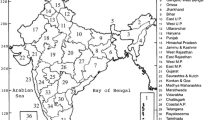Summary
This is a temporal and comparative analysis of thunderstorms and some related phenomena in three towns in the northern part of Nigeria.
On a diurnal basis, the three stations show both an afternoon and nocturnal maximum with the nocturnal maximum occurring at 0000–0100 LST for all phenomena.
Seasonally, while thundery activities peak first in Jos, Kaduna and Zaria in that order, lightning and squalls peak in the reverse order. This implies that for thundery activities, an ample amount of moisture is required while limited moisture is needed for the initiation of lightning and squalls.
Compared to Jos and Kaduna, Zaria possesses a higher amplitude for all the three phenomena under consideration. This stems from the fact that Zaria is closer to the centre of the disturbance line generating zone than the other stations.
The diurnal cycle of occurrence of thunderstorms and related phenomena results from the diurnal cycle of insolation in the cloudless area in the vicinity of an easterly wave and radiational forcing of the cloudy region of the perturbed area.
Zusammenfassung
Es handelt sich um eine zeitliche und vergleichende Analyse von Gewittern und mit ihnen verbundenen Phänomenen aus drei Städten im nördlichen Teil Nigerias. Im Tagesgang zeigen die drei Stationen ein Nachmittagsund ein Nachtmaximum, wobei das Nachtmaximum für alle Phänomene zwischen 0 und 1 Uhr Lokalzeit auftritt.
Im Jahresgang wandert das Maximum der Gewitteraktivität von Jos über Kaduna nach Zaria, während Blitze und “Squalls” ihr Maximum in umgekehrter Reihenfolge haben. Für Gewitter ist offenbar reichlich Feuchtigkeit notwendig, während für die Entstehung von Blitzen und “Squalls” geringere Mengen ausreichen.
Im Vergleich mit Jos und Kaduna besitzt Zaria für alle drei behandelten Phänomene die höchste Amplitude. Das rührt daher, daß Zaria näher der die Störungslinie erzeugenden Zone liegt als die anderen Stationen.
Der Tagesgang der Gewitteraktivität und der anderen Phänomene entsteht durch den Tagesgang der Einstrahlung in der wolkenlosen Zone nahe einer östlichen Welle und durch den Einfluß der bewölkten Gebiete im Störungsbereich.
Similar content being viewed by others
References
Adedokun JA (1981) Potential instability and precipitation occurrence within an inter-tropical discontinuity environment. Arch Met Geoph Biocl A30: 69–86
Albrecht B, Cox SK (1975) The large-scale response of the tropical atmosphere to cloud-modulated infrared heating. J Atm Sci 32: 16–24
Aspliden CI, Tourre Y, Sabine TB (1976) Some climatological aspects of West African disturbance lines during GATE. Mon Wea Rev 104: 1029–1035
Atkinson GD (1967) Thunderstorms in SE Asia. 1st Weather Wind Technical Study
Atkinson GD (1966) A preliminary estimate for extreme wind speeds in Thailand. 1st Weather Wind Technical Study, no 3
Balogun EE (1981) Seasonal and spatial variations in thunderstorm activities over Nigeria. Weather 36: 192–197
Blackadar AK (1957) Boundary-layer wind maxima and their significance for the growth of nocturnal inversions. Bull Am Met Soc 38: 283–290
Brier GW, Simpson J (1969) Tropical cloudiness and rainfall related to pressure and tidal variations. Quart J R Met Soc 95: 120–147
Burpee R (1975) Some features of synoptic scale waves based on a compositing analysis of GATE data (unpublished manuscript quoted in Asplinden et al. 1976)
Eldridge RH (1957) A synoptic study of West African disturbance lines. Quart J R Met Soc 83: 303–314
Frisby EM, Sansom HW (1967) Hail incidence in the tropics. J Appl Met 6(2): 339–354
Ghosh BP (1967) A radar study of thunderstorms and convective clouds around New Delhi during south-west monsoon season. Indian J of Met and Geophys 18(3): 391–396
Gray WM, Jacobson RW (1977) Diurnal variation of deep cumulus convection. Mon Wea Rev 105: 1171–1188
Hamilton RA, Archbold JW (1945) Meteorology of Nigeria and adjacent territory. Quart J Met Soc 71: 231–264
Hering WS, Borden TR (1962) Diurnal variations in the summer wind field over the central United States. J Atm Sci 19: 81–86
Hewson EW (1943) The application of wet-bulb potential temperature to air mass analysis. Quart J R Met Soc 63: 323–335
Holton JR (1968) The diurnal boundary-layer wind oscillation above sloping terrain. Tellus 19: 199–205
Ireland DH (1962) The little dry season of southern Nigeria. Nigerian Geographical J 5: 7–21
Lettau H (1967) Small to large features of the boundarylayer structure over mountain slopes. Proc Symposium on Mountain Meteorology Department of Atm Sci, Colorado State University, p 221
Means LL (1944) The nocturnal maximum occurrence of thunderstorm in the midwestern States. Dept of Met, University of Chicago, Misc Rep no 16, p 37
Ojo O (1977) The climates of West Africa. Heinemann, London
Okulaja FO (1969) The frequency of distribution of Lagos/Ikeja wind gust. J Appl Met 7(3): 379–383
Omotosho JG (1968) Comparison of the mean and daily variations in the kinematic and deep convective cloud fields over GATE A/B, B and C-scales. The Nigerian Met J 1(1): 14–31
Palmen E, Newton CW (1969) Atmospheric circulation systems. Academic Press, New York
Pitchford KL, London J (1962) The low level jet as related to nocturnal thunderstorms over midwest United States. J Appl Met 1: 43–47
Riel H, Malkus JS (1958) On the heat balance in the equatorial trough zone. Geophysics 6: 503–538
Sharma KK (1966) Squall at Nagpur. Indian J of Met and Geophys 17(1): 77–82
Thorpe AJ (1981) Thunderstorm dynamics — a challenge to the physicist. Weather 36: 108–114
Walker HO (1958) The monsoon in West Africa. Ghana Meteorological Department, Departmental note no 9
Wallace JM (1975) Diurnal variations in precipitation and thunderstorm frequency over the coterminous United States. Mon Wea Rev 103: 406–419
World Meteorological Organization (1953) World distribution of thunderstorm days. WMO, OMN no 21 TB6, part 1 : tables
Author information
Authors and Affiliations
Additional information
With 10 Figures
Rights and permissions
About this article
Cite this article
Salau, O.A. Temporal and comparative analysis of thunderstorms and some related phenomena in Zaria, Jos, and Kaduna (Nigeria). Theor Appl Climatol 37, 220–232 (1986). https://doi.org/10.1007/BF00867579
Received:
Revised:
Issue Date:
DOI: https://doi.org/10.1007/BF00867579




